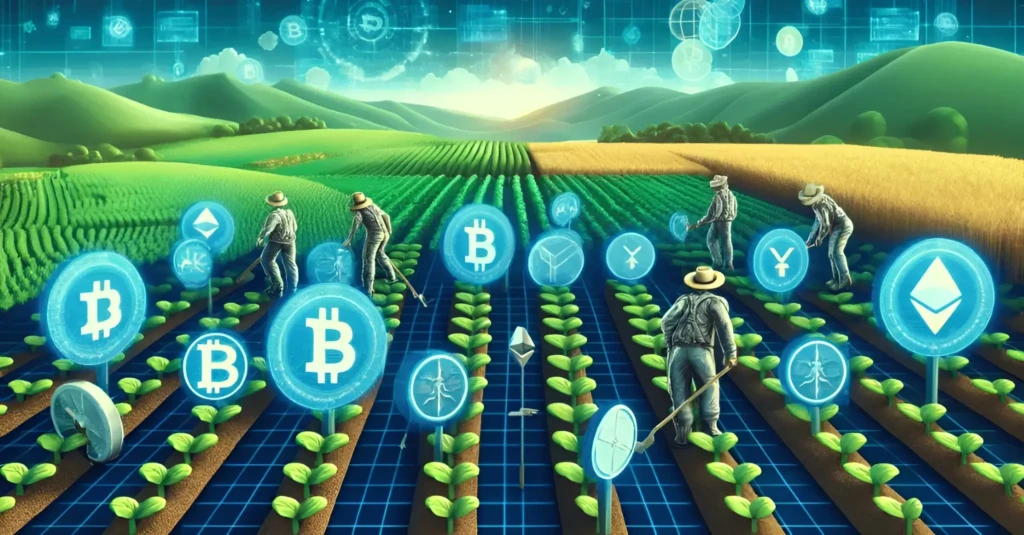What Is DeFi Yield Generation?
What is DeFi yield generation? At its core, it is the practice of earning passive income by supplying crypto assets to decentralized finance (DeFi) protocols. Instead of entrusting funds to a traditional bank, investors interact directly with blockchain-based smart contracts to lend, stake, or provide liquidity—and earn rewards.
This emerging financial mechanism has grown from a niche experiment to a multibillion-dollar market, reshaping how crypto users think about wealth creation. But beneath the enticing returns lie complex strategies and significant risks.
The Mechanics Behind DeFi Yield Generation
DeFi yield generation operates without centralized intermediaries. Smart contracts handle lending, borrowing, and reward distribution automatically. Participants typically engage in three primary activities:
Lending and Borrowing
Platforms like Aave and Compound allow users to lend digital assets to earn interest. Borrowers collateralize their loans with other crypto holdings, creating a self-sustaining cycle of liquidity and yield.
Liquidity Provision
Decentralized exchanges (DEXs) such as Uniswap incentivize users to provide liquidity by depositing token pairs. In return, providers earn trading fees and, in some cases, native governance tokens.
Staking and Yield Farming
Staking secures proof-of-stake networks while paying participants block rewards. Yield farming, a more advanced strategy, involves moving assets between protocols to capture the highest possible returns. These approaches are often combined for maximum DeFi yield generation.
Why Investors Are Drawn to DeFi Yield Generation
The allure is simple: attractive yields, often significantly higher than those from traditional savings accounts or bonds. With global interest rates fluctuating, DeFi offers:
- High Annual Percentage Yields (APYs): Some protocols have historically advertised double- or triple-digit returns.
- Permissionless Access: Anyone with a crypto wallet can participate—no credit checks or minimum balances required.
- Composability: Investors can stack strategies, such as lending stablecoins and simultaneously using those assets as collateral elsewhere.
However, these benefits come with their own set of trade-offs.
Risks and Challenges
Smart Contract Vulnerabilities
Bugs or exploits in smart contracts can lead to loss of funds. High-profile hacks have drained hundreds of millions of dollars from DeFi protocols.
Market Volatility
Crypto prices swing dramatically. Collateral values can plummet, triggering liquidations and eroding returns.
Regulatory Uncertainty
Governments are increasingly scrutinizing DeFi. New regulations could affect accessibility or impose additional compliance requirements.
Understanding these risks is critical for anyone exploring DeFi yield generation.
Key Strategies for DeFi Yield Generation
Stablecoin Lending
Stablecoins like USDC or DAI reduce exposure to price volatility while providing competitive interest rates.
Liquidity Mining
Investors supply tokens to decentralized exchanges, earning fees and governance tokens. Monitoring impermanent loss—the risk of price divergence between paired tokens—is essential.
Automated Yield Optimizers
Platforms such as Yearn Finance automatically move funds between protocols to maximize yield. These “set-and-forget” tools simplify complex strategies but require trust in the platform’s security.
Tools and Metrics to Monitor
When pursuing DeFi yield generation, seasoned investors rely on metrics like Total Value Locked (TVL), protocol audits, and on-chain analytics. Websites like DeFi Llama track ecosystem growth and can help gauge a protocol’s health and popularity.
These resources help readers navigate related concepts for a more complete understanding of DeFi.
FAQ: What Is DeFi Yield Generation?
What is DeFi yield generation in simple terms?
It’s the process of earning passive income by lending, staking, or providing liquidity in decentralized finance protocols.
How risky is DeFi yield generation?
Risks include smart contract hacks, market volatility, and regulatory shifts. Due diligence and diversification are essential.
Which platforms are best for DeFi yield generation?
Popular choices include Aave for lending, Uniswap for liquidity provision, and Yearn Finance for automated yield optimization.
Can beginners start DeFi yield generation easily?
Yes, but newcomers should start small, use audited protocols, and understand wallet security to avoid costly mistakes.
Is DeFi yield generation legal?
It’s generally legal, but regulations vary by country and are evolving rapidly. Always check local laws.
The Future of DeFi Yield Generation
As institutional players explore decentralized finance and layer-2 networks reduce transaction costs, DeFi yield generation may become more accessible and efficient. Innovations such as real-world asset tokenization and cross-chain liquidity are poised to broaden opportunities further.
However, sustainability remains in question. As markets mature and competition intensifies, yields may decline. Investors who thrive will be those who adapt—balancing risk, diversification, and ongoing research.
Bottom Line:
What is DeFi yield generation? It’s a groundbreaking way to earn returns on crypto assets without banks or brokers, leveraging blockchain technology to create a new paradigm of financial independence. For investors willing to navigate the risks, the potential rewards remain compelling, making DeFi yield generation one of the most transformative trends in modern finance.

